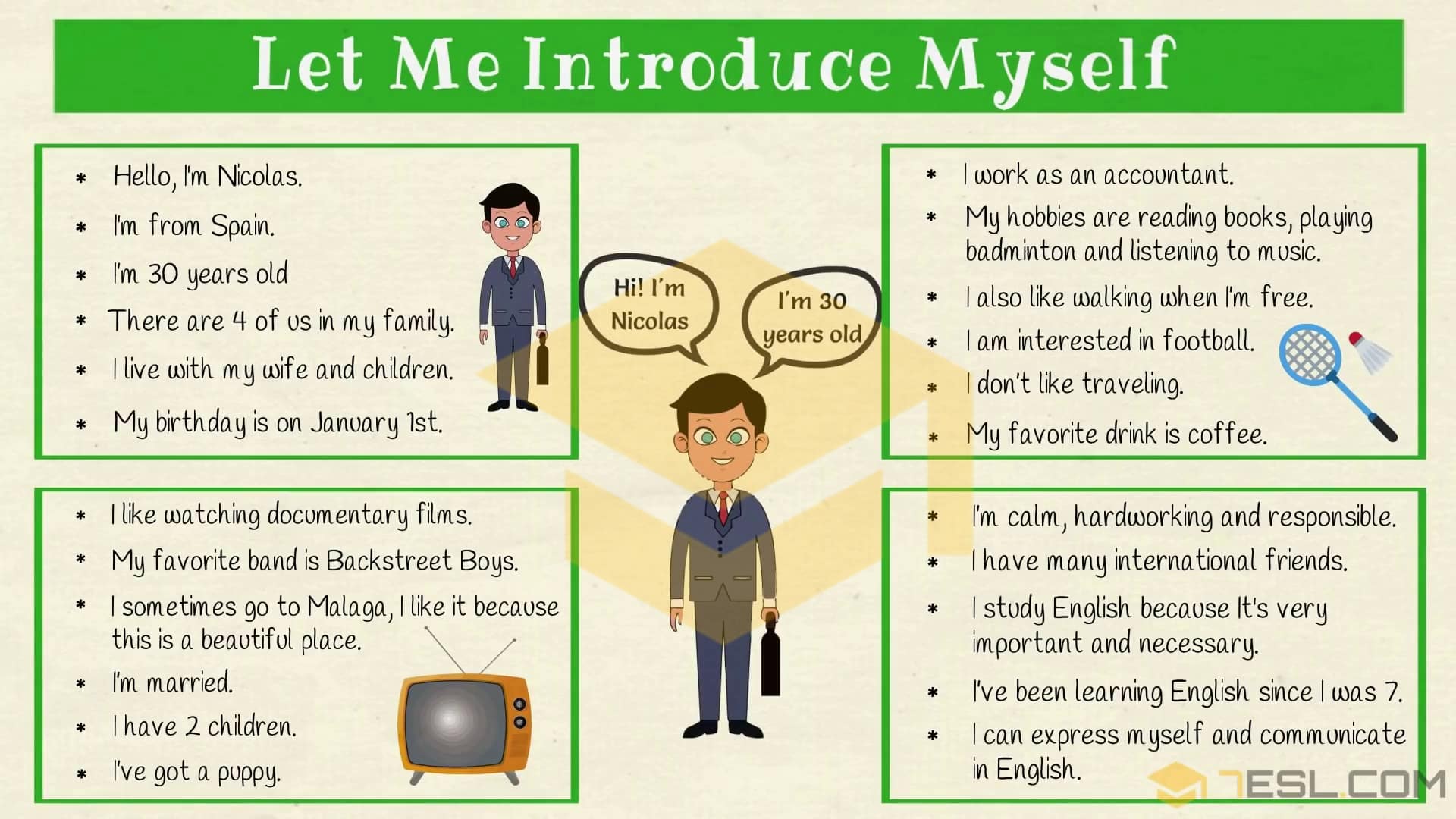In today’s multicultural and globalized world, being able to introduce oneself in English is an essential skill. Whether you are attending a job interview, meeting new people, or participating in a social event, a self-introduction sets the stage for the interaction and helps create a positive first impression. This blog will provide you with a comprehensive guide to self introduction in English, covering everything from the basic structure to useful tips and phrases.
Basic Structure of a Self Introduction
A self introduction in English is a crucial part of any personal or professional interaction. It is an opportunity to introduce oneself to others, allowing them to get to know you and form an initial impression. The basic structure of a self-introduction typically consists of several key components that help convey important information about oneself. In this article, we will explore the basic structure of a self introduction and discuss each component in detail.
Greeting
The self-introduction usually begins with a polite greeting. This sets a friendly and welcoming tone for the conversation or presentation. It is essential to make a positive first impression by using appropriate greetings, such as “Good morning/afternoon/evening” or “Hello everyone.”
Name and Background
The next step is to introduce yourself in an interview by stating your name and providing some background information. This may include your profession, educational background, or any relevant experiences. For example, “My name is John Smith, and I am a software engineer with five years of experience in the tech industry.”
Personal Details
After introducing yourself, it is common to share some personal details that help others understand you better. This can include hobbies, interests, or unique experiences. Sharing personal details adds depth to your introduction and allows others to connect with you on a more personal level. For instance, “In my free time, I enjoy playing the guitar and exploring new hiking trails.”
Achievements and Skills
This component focuses on highlighting your accomplishments and skills that are relevant to the context of the introduction. It is an opportunity to showcase your expertise and demonstrate why you are qualified for a particular role or position. For example, “I have successfully led multiple software development projects and have expertise in programming languages such as Python and Java.”
Goals and Objectives
Another important aspect of a self-introduction is discussing your goals and objectives. This demonstrates your ambition and allows others to understand what motivates you. It could be related to personal growth, career aspirations, or specific projects you want to undertake. For instance, “My goal is to become a senior software engineer and contribute to the development of innovative solutions in the tech industry.”
Conclusion
The self-introduction concludes with a concise summary and a closing statement. This serves as a final impression and leaves a lasting impact on the audience. It is important to end on a positive note and express gratitude for the opportunity to introduce yourself. For example, “Thank you for giving me this opportunity to introduce myself. I look forward to getting to know all of you better.”
Useful Phrases for Self-Introduction
Self-introductions are an essential part of everyday life, whether you are meeting new people, attending a job interview, or participating in social events. It is important to make a good first impression, and one way to do that is by using effective introduction about self phrases. These phrases can help you confidently introduce yourself and convey key information about your background, interests, and goals.
Here are some useful phrases for self-introduction:
- “Hello, my name is [Your Name].” This simple phrase is the most basic way to introduce yourself. It establishes your identity and sets the tone for further conversation.
- “I’m from [Your City/Country].” Sharing your place of origin can help create a connection with others and provide a starting point for conversation.
- “I’m currently studying/working as [Your Occupation].” This phrase allows you to share your current educational or professional status, giving others an idea of your background and interests.
- “I have a passion for [Your Hobby/Interest].” Sharing your hobbies or interests can help you find common ground with others and initiate conversations on topics you are passionate about.
- “I’m here today because [Reason for Attending].” If you are introducing yourself in a specific context, such as a conference or event, explaining the reason for your presence can help others understand your motives and create connections based on shared interests.
- “In the future, I hope to [Your Goal/Aspiration].” Expressing your goals and aspirations can demonstrate your ambition and give others an insight into your long-term plans.
- “I enjoy [Activity/Skill].” This phrase allows you to highlight specific activities or skills you enjoy, showcasing your diverse interests and talents.
- “I’m excited to meet new people and learn from their experiences.” Showing enthusiasm for meeting new people and learning from them can make you approachable and open to building meaningful connections.
- “I believe in [Personal Value/Belief].” Sharing your personal values or beliefs can help others understand your principles and create deeper connections based on shared ideals.
- “I’m looking forward to the opportunities this experience will bring.” Expressing anticipation for future opportunities demonstrates your positive outlook and willingness to embrace new experiences.
Tips for an Effective Self Introduction in English
Introduction of self in a new environment can be daunting, especially when it involves speaking in a language that is not your native tongue. However, with a few tips and practice, you can master the art of delivering an effective self introduction in English. Here are some key points to keep in mind:
Keep it concise
When introducing yourself, it’s important to be concise and to the point. Provide relevant information about yourself without going into unnecessary details. A brief introduction will keep your audience engaged and interested in what you have to say.
Start with a greeting
Begin your self-introduction in English by greeting the audience. A simple “Good morning/afternoon/evening” followed by your name is a polite way to start. This sets a friendly tone and helps establish a connection with the listeners.
State your purpose
Clearly state why you are introducing yourself. Are you attending a conference, job interview, or social gathering? Knowing your purpose will help you tailor your introduction accordingly and make it more relevant to the situation.
Mention your background
Share some information about your background, such as your education, work experience, or any relevant achievements. Keep it concise and focus on the aspects that are most relevant to the context in which you are introducing yourself.
Highlight your skills and interests
Mention a few key skills or interests that showcase your strengths and personality. This will help create a memorable impression and make you stand out from the crowd. Choose skills or interests that are relevant to the situation or align with the goals of the group you are addressing.
Use simple language
While it’s important to showcase your language skills, avoid using complex vocabulary or technical jargon that may confuse your audience. Stick to clear and simple language that is easy to understand.
Practice and confidence
Practice your self-introduction beforehand to ensure a smooth delivery. Rehearse in front of a mirror or with a friend to build confidence and refine your presentation. Remember to maintain eye contact and speak clearly and confidently.
Be mindful of cultural differences
When introducing yourself in English, be aware of cultural differences that may influence communication styles. Adapt your introduction to suit the cultural norms of the environment you are in.
Show enthusiasm and passion
Infuse your self-introduction with enthusiasm and passion for what you do. This will help captivate your audience’s attention and leave a positive impression.
End with a call-to-action
Wrap up your self-introduction with a call-to-action, such as asking if anyone has questions or expressing your eagerness to connect with others. This encourages engagement and invites further interaction. You can master the Self -introductions by following the Tips. In-spite your language not being English, you can still crack the Interview in English and get your dream job.
Conclusion
Mastering the art of self introduction in English is crucial for various social and professional situations. By following the basic structure, using useful phrases, and applying the tips mentioned in this guide, you will be well-prepared to introduce yourself confidently and effectively. Remember, practice makes perfect, so take every opportunity to refine your self introduction skills. Good luck!






